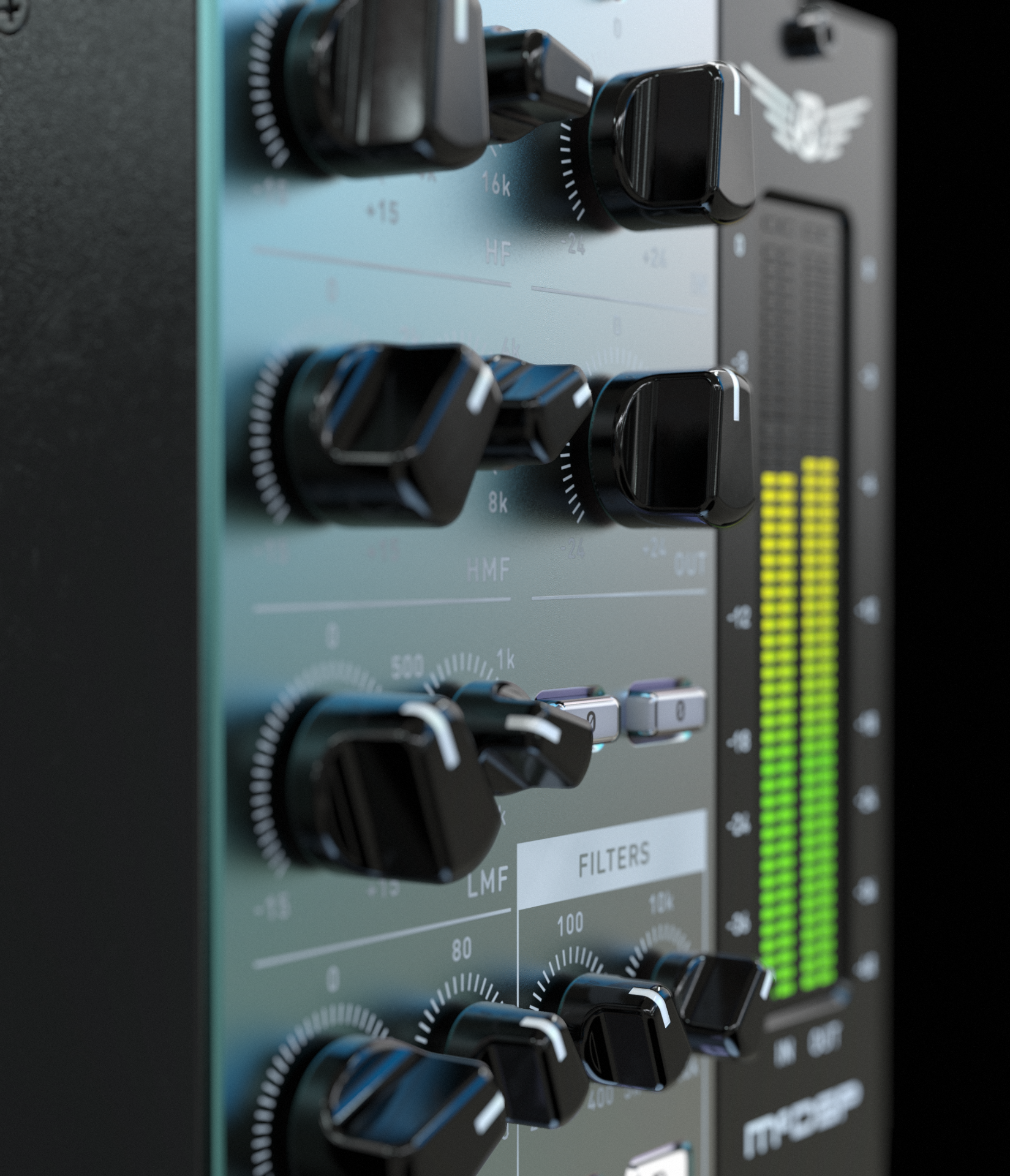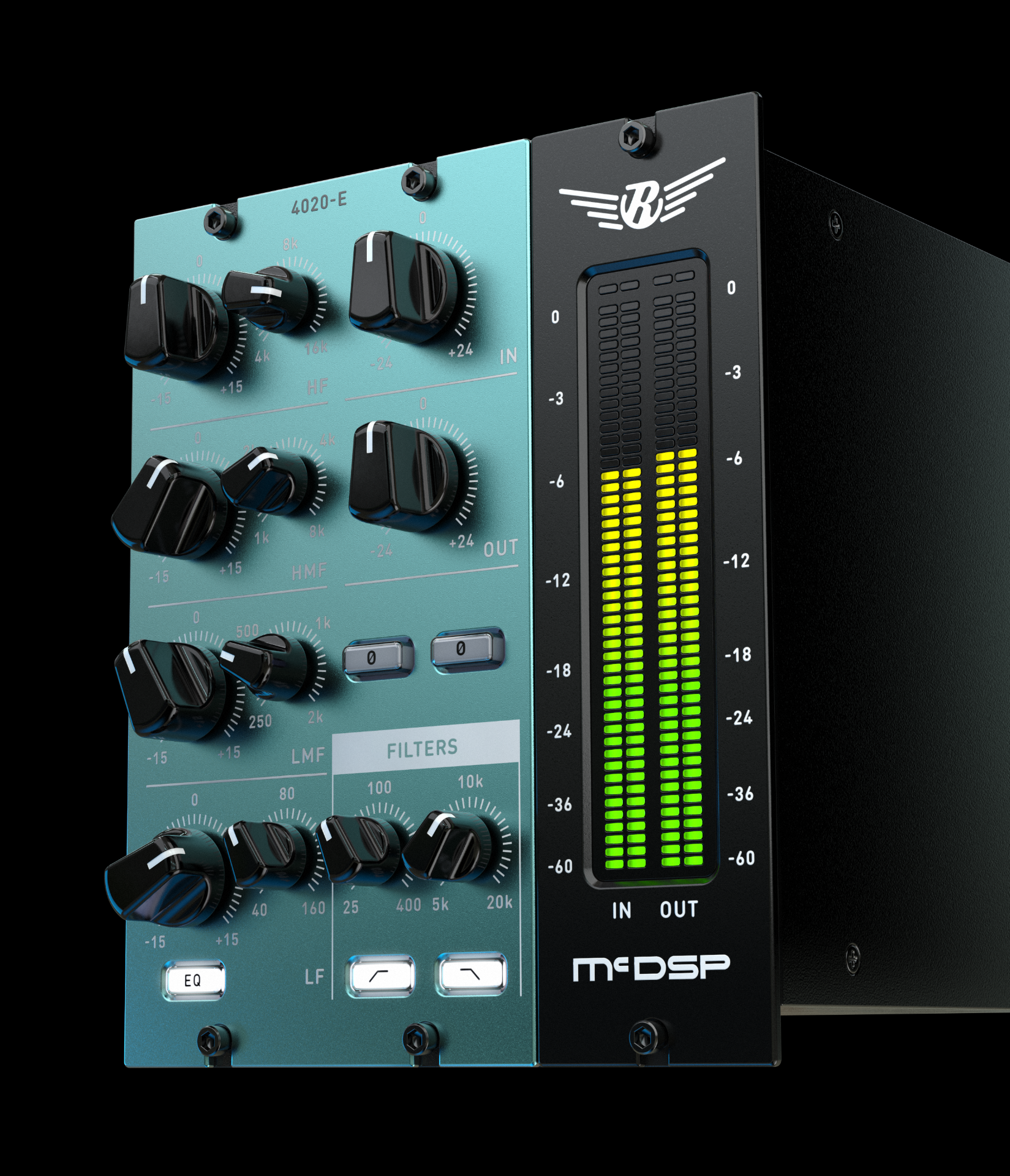


- Details
- Features
- Reviews
The 4020 Retro EQ is a four-band EQ and complimentary filter set. The HF and LF bands are shelving EQ, with two additional parametric EQs at the HMF and LMF bands. All EQ bands operate on a unique gain dependent variable slope/Q system for a vintage smooth sound and increased boost/cut frequency selectivity high gains. The HPF and LPF filters use a unique split-octave design giving a 12 dB/Oct slope near the selected frequency, and a maximum slope of 24 dB/Oct.
All Retro plug-ins use a McDSP designed output stage topology to eliminate digital clipping at any output level and produce a smoother distortion characteristic. This feature is in addition to the analog saturation modeling that has made McDSP famous over the last decade.
Retro plug-ins are a line of ‘classics’ that can live up to their own name without emulating something else.
The 4020 Retro EQ is a 4 band EQ (LF shelf, LMF and HMF parametrics, HF shelf) with a high pass and low pass filter section. Ok boring right? Hold on audio dweeb.
Starting with the EQ section – the slope / Q of the shelving and parametric equalizers varies as gain is adjusted, in a manner unique to the 4020 Retro EQ. McDSP savvy customers might wonder if FilterBank, being the ‘Every EQ Ever Made’ plug-in, could duplicate the response curves of the 4020 Retro EQ. It might get close, but then those curves would have to be adjusted every time the EQ gain was updated. So think of the 4020 Retro EQ of having all those Peak-Slope-Dip and Q smarts under the hood, and then being able to adjust those parameters based on the user selected frequency and gain settings. Furthermore, the gain staging, EQ algorithm, and fabulous (hey this is my article) Anti-Clip circuit at the output stage are all new design elements not present in previous McDSP equalizer plug-ins.
Both the EQ and filter section frequency controls are calibrated in octaves (instead of decades) for a different twist on the audio effects when you twist those controls. The EQ section frequency ranges do not completely overlap, however they are designed for the optimum range their dynamic shape can cover in the audio spectrum.
The filter section uses a new design that varies the slope from a gradual 6 dB/Oct at the selected frequency to a maximum of 24 dB/Oct. As with the EQ section, the widely popular McDSP FilterBank plug-in could not match the varying slope response in the filter section of the 4020 Retro EQ.
| Product Name | McDSP 4020 Retro EQ HD |
|---|---|
| Brand | MCDSP |
| Condition | New |
| MPN | M-PI-4020 |
| Shipping Option | Electronic Delivery |
- Unique original algorithms with transparent yet vintage sound
- Variable slope filtering
- Variable Q/slope Shelving and Parametric EQ
- Anti-Clip Output Stage Topology
- Analog Saturation Modeling
- Double Precision Processing
- Ultra Low Latency
- Mono and stereo versions
McDSP 4020 Retro EQ HD
The 4020 Retro EQ is a four-band EQ and complimentary filter set. The HF and LF bands are shelving EQ, with two additional parametric EQs at the HMF and LMF bands. All EQ bands operate on a unique gain dependent variable slope/Q system for a vintage smooth sound and increased boost/cut frequency selectivity high gains. The HPF and LPF filters use a unique split-octave design giving a 12 dB/Oct slope near the selected frequency, and a maximum slope of 24 dB/Oct.
All Retro plug-ins use a McDSP designed output stage topology to eliminate digital clipping at any output level and produce a smoother distortion characteristic. This feature is in addition to the analog saturation modeling that has made McDSP famous over the last decade.
Retro plug-ins are a line of ‘classics’ that can live up to their own name without emulating something else.
The 4020 Retro EQ is a 4 band EQ (LF shelf, LMF and HMF parametrics, HF shelf) with a high pass and low pass filter section. Ok boring right? Hold on audio dweeb.
Starting with the EQ section – the slope / Q of the shelving and parametric equalizers varies as gain is adjusted, in a manner unique to the 4020 Retro EQ. McDSP savvy customers might wonder if FilterBank, being the ‘Every EQ Ever Made’ plug-in, could duplicate the response curves of the 4020 Retro EQ. It might get close, but then those curves would have to be adjusted every time the EQ gain was updated. So think of the 4020 Retro EQ of having all those Peak-Slope-Dip and Q smarts under the hood, and then being able to adjust those parameters based on the user selected frequency and gain settings. Furthermore, the gain staging, EQ algorithm, and fabulous (hey this is my article) Anti-Clip circuit at the output stage are all new design elements not present in previous McDSP equalizer plug-ins.
Both the EQ and filter section frequency controls are calibrated in octaves (instead of decades) for a different twist on the audio effects when you twist those controls. The EQ section frequency ranges do not completely overlap, however they are designed for the optimum range their dynamic shape can cover in the audio spectrum.
The filter section uses a new design that varies the slope from a gradual 6 dB/Oct at the selected frequency to a maximum of 24 dB/Oct. As with the EQ section, the widely popular McDSP FilterBank plug-in could not match the varying slope response in the filter section of the 4020 Retro EQ.
| Product Name | McDSP 4020 Retro EQ HD |
|---|---|
| Brand | MCDSP |
| Condition | New |
| MPN | M-PI-4020 |
| Shipping Option | Electronic Delivery |
- Unique original algorithms with transparent yet vintage sound
- Variable slope filtering
- Variable Q/slope Shelving and Parametric EQ
- Anti-Clip Output Stage Topology
- Analog Saturation Modeling
- Double Precision Processing
- Ultra Low Latency
- Mono and stereo versions
- Choosing a selection results in a full page refresh.
- Opens in a new window.



